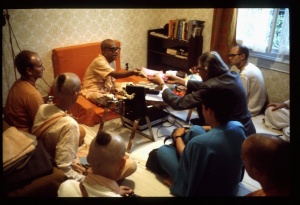SB 7.9.36

A.C. Bhaktivedanta Swami Prabhupada
TEXT 36
- evaṁ sahasra-vadanāṅghri-śiraḥ-karoru-
- nāsādya-karṇa-nayanābharaṇāyudhāḍhyam
- māyāmayaṁ sad-upalakṣita-sanniveśaṁ
- dṛṣṭvā mahā-puruṣam āpa mudaṁ viriñcaḥ
SYNONYMS
evam — in this way; sahasra — thousands and thousands; vadana — faces; aṅghri — feet; śiraḥ — heads; kara — hands; uru — thighs; nāsa-ādya — noses, etc.; karṇa — ears; nayana — eyes; ābharaṇa — varieties of ornaments; āyudha — varieties of weapons; āḍhyam — endowed with; māyā-mayam — all demonstrated by unlimited potency; sat-upalakṣita — appearing in different symptoms; sanniveśam — combined together; dṛṣṭvā — seeing; mahā-puruṣam — the Supreme Personality of Godhead; āpa — achieved; mudam — transcendental bliss; viriñcaḥ — Lord Brahmā.
TRANSLATION
Lord Brahmā could then see You possessing thousands and thousands of faces, feet, heads, hands, thighs, noses, ears and eyes. You were very nicely dressed, being decorated and bedecked with varieties of ornaments and weapons. Seeing You in the form of Lord Viṣṇu, Your symptoms and form being transcendental, Your legs extending from the lower planets, Lord Brahmā achieved transcendental bliss.
PURPORT
Lord Brahmā, being completely pure, could see the original form of the Lord as Viṣṇu, having many thousands of faces and forms. This process is called self-realization. Genuine self-realization consists not of perceiving the impersonal effulgence of the Lord, but seeing face to face the transcendental form of the Lord. As distinctly mentioned here, Lord Brahmā saw the Supreme Lord as mahā-puruṣa, the Supreme Personality of Godhead. Arjuna also saw Kṛṣṇa in this same way. Therefore he told the Lord, paraṁ brahma paraṁ dhāma pavitraṁ paramaṁ bhavān puruṣaṁ śāśvataṁ divyam: (BG 10.12) "You are the Supreme Brahman, the ultimate, the supreme abode and purifier, the Absolute Truth and the eternal divine person." The Lord is parama-puruṣa, the supreme form. Puruṣaṁ śāśvatam: He is everlastingly the supreme enjoyer. It is not that the impersonal Brahman assumes a form; on the contrary, the impersonal Brahman effulgence is an emanation from the supreme form of the Lord. Upon being purified, Brahmā could see the supreme form of the Lord. The impersonal Brahman cannot have heads, noses, ears, hands and legs. This is not possible, for these are attributes of the Lord's form.
The word māyāmayam means "spiritual knowledge." This is explained by Madhvācārya. Māyāmayaṁ jñāna-svarūpam. The word māyāmayam, describing the Lord's form, should not be taken to mean illusion. Rather, the Lord's form is factual, and seeing this form is the result of perfect knowledge. This is confirmed in Bhagavad-gītā: bahūnāṁ janmanām ante jñānavān māṁ prapadyate (BG 7.19). The word jñānavān refers to one who is perfectly in knowledge. Such a person can see the Personality of Godhead, and therefore he surrenders unto the Lord. The Lord's being symptomized by a face, nose, ears and so on is eternal. Without such a form, no one can be blissful. The Lord, however, is sac-cid-ānanda-vigraha, as stated in the śāstra (īśvaraḥ paramaḥ kṛṣṇaḥ sac-cid-ānanda-vigrahaḥ (BS 5.1)). When one is in perfect transcendental bliss, he can see the Lord's supreme form (vigraha). In this regard, Śrīla Madhvācārya says:
- gandhākhyā devatā yadvat
- pṛthivīṁ vyāpya tiṣṭhati
- evaṁ vyāptaṁ jagad viṣṇuṁ
- brahmātma-sthaṁ dadarśa ha
Lord Brahmā saw that as aromas and colors spread throughout the earth, the Supreme Personality of Godhead pervades the cosmic manifestation in a subtle form.